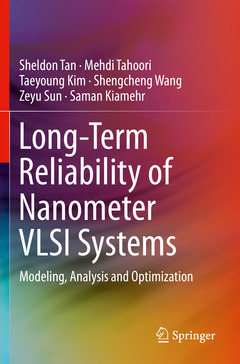Long-Term Reliability of Nanometer VLSI Systems, 1st ed. 2019 Modeling, Analysis and Optimization

- Reviews classic Electromigration (EM) models, as well as existing EM failure models and discusses the limitations of those models;
- Introduces a dynamic EM model to address transient stress evolution, in which wires are stressed under time-varying current flows, and the EM recovery effects. Also includes new, parameterized equivalent DC current based EM models to address the recovery and transient effects;
- Presents a cross-layer approach to transistor aging modeling, analysis and mitigation, spanning multiple abstraction levels;
- Equips readers for EM-induced dynamic reliability management and energy or lifetime optimization techniques, for many-core dark silicon microprocessors, embedded systems, lower power many-core processors and datacenters.
Part I. New physics-based EM analysis and system-level dynamic reliability management.- Chapter 1. Introduction.- Chapter 2. Physics Based EM Modeling.- Chapter 3. Fast EM Stress Evolution Analysis Using Krylov Subspace Method.- Chapter 4. Fast EM Immortatlity Analysis For Multisegment Copper Interconnect Wires.- Chapter 5. Dynamic EM Models For Transient Stress Evolution and Recovery.- Chapter 6. Compact EM Models for Multi-SEgment Interconnect Wires.- Chapter 7. EM Assesment for Power Grid Networks.- Chapter 8. Resource Based EM Modeling for Multi-Crore Microprocessors.- Chapter 9. DRM and Optimization for Real Time Embedded Systems.- Chapter 10. Learning Based DRM and Energy Optimization for Many Core Dark Silicaon Processors.- Chapter 11. Recovery Aware DRM for Near Threshold Dark Silicon Processors.- Chapter 12. Cross-Layer DRM and Optimization For Datacenter Systems.- Part II. Transistor Aging Effects and Reliability.- 13. Introduction.- Chapter 14. Aging AWare Timings Analysis.- Chapter 15. Aging Aware Standard Cell Library Optimization Methods.- Chapter 16. Aging Effects In Sequential Elements.- Chapter 17. Aging Guardband Reduction Through Selective Flip Flop Optimization.- Chapter 18. Workload Aware Static Aging Monitoring and Mitigation of Timing Critical Flip Flops.- Chapter 19. Aging Relaxation at Micro Architecture Level Using Special NOPS.- Chapter 20. Extratime Modelling and Analyis of Transistor Agin at Microarchitecture Level.- Chapter 21. Reducing Processor Wearout By Exploiting The Timing Slack of Instructions.
Sheldon Tan is a Professor in the Department of Electrical and Computer Engineering, University of California, Riverside, CA. He also is a cooperative faculty member in the Department of Computer Science and Engineering at UCR. He received Ph.D. degree in electrical and computer engineering from the University of Iowa, Iowa City, in 1999. His research interests include VLSI reliability modeling, optimization and management at circuit and system levels, hardware security, thermal modeling, optimization and dynamic thermal management for many-core processors, parallel computing and adiabatic and Ising computing based on GPU and multicore systems. He has published more 290 technical papers and has co-authored 6 books on those areas. Dr. Tan received NSF CAREER Award in 2004. He also received three Best Paper Awards from ASICON’17, ICCD'07, DAC’09. He also received the Honorable Mention Best Paper Award from SMACD’18. He was a Visiting Professorof Kyoto University as a JSPS Fellow from Dec. 2017 to Jan. 2018. He is now serving as Editor in Chief for Elsevier’s Integration, the VLSI Journal, the Associate Editor for three journals: IEEE Transaction on VLSI Systems (TVLSI), ACM Transaction on Design Automation of Electronic Systems (TODAE) and Elsevier’s Microelectronics Reliability.
Mehdi Tahoori is a full professor and Chair of Dependable Nano-Computing (CDNC) at the Institute of Computer Science & Engineering (ITEC), Department of Computer Science, Karlsruhe Institute of Technology (KIT), Germany. He received his PhD and M.S. degrees in Electrical Engineering from Stanford University in 2003 and 2002, respectively, and a B.S. in Computer Engineering from Sharif University of Technology in Iran, in 2000. In 2003, he joined the Electrical and Computer Engineering Department at the Northeastern University as an assistant professor where he promoted to the rank of associate professor with tenure in 2009. From August
Date de parution : 09-2020
Ouvrage de 460 p.
15.5x23.5 cm
Date de parution : 09-2019
Ouvrage de 460 p.
15.5x23.5 cm
Disponible chez l'éditeur (délai d'approvisionnement : 15 jours).
Prix indicatif 158,24 €
Ajouter au panier

